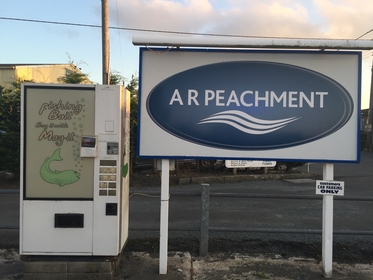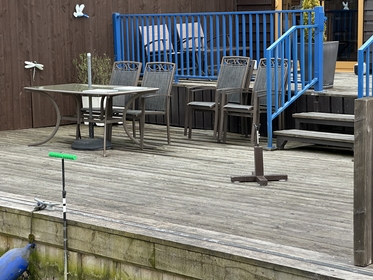Fishing At Swallowdale
Norfolk Fishing Holiday
Swallowdale Holiday Home makes the perfect self-catering Norfolk fishing holiday waterside accommodation. Whether you're a serious angler or have never fished before the Norfolk Broads is the ideal place for fishing, it must be a real temptation for serious anglers to spend their whole holiday fishing in the beautiful Norfolk countryside.
Coarse fishing holidays in the Norfolk Broads national park have become very popular over the last few years. The whole family can enjoy hours of fun family fishing the waters of the broads.
Fishing Holidays In Norfolk
Swallowdale has a 33ft private waterside decking overlooking the River Yare where guests can moor a day boat, or fish day and night whenever they want. If you fancy being more adventurous and hiring a day boat for your holiday, why not explore all the beautiful fishing spots along the River Yare while enjoying the peaceful surroundings, the beautiful countryside and the fantastic wildlife while fishing in Norfolk?
So why not make Swallowdale holiday home in Brundall your next holiday?
Norfolk Broads Fishing
The Norfolk Broads is the largest area in the UK for free fishing, with over 125 miles of beautiful, navigable waterways.
The Norfolk Broads course fishing season starts on the 16th of June and ends on the 14th of March. To fish the waters of the Norfolk Broads, you will need a valid Environment Agency fishing rod licence. You can purchase a 1-day, 8-day or 12-month licence from the Post Office. You risk a fine of up to £2,500 if you cannot show a valid fishing licence when asked. Children under 13 do not need a licence. Children aged between 13 and 16 need a licence, but they are free. A fishing licence is reasonably priced and supports improvements to the Norfolk Broads. It's not worth breaking the law for a few pounds!
The River Yare
The River Yare is approximately 52 miles long. It starts in Dereham, 15 miles west of the fine city of Norwich and ends at Breydon Water in Great Yarmouth, where it joins the North Sea.
During the summer months, the River Yare can be very busy with day boats, sailing yachts and holidaymakers affecting the fishing at many Norfolk holiday cottages. Fortunately, the river is wide enough in Brundall and has a speed limit of only 5 mph, so it does not affect fishing at Swallowdale, making it one of the best fishing cottages on the Norfolk Broads.
The River Yare is tidal and has two high and two low tides every 24 hours. The tides measured from sea level can vary considerably from -0.8 metres up to 1.18 metres. Up-to-date tide levels can be found here.
The beautiful village of Brundall has a yacht club situated next to Coldham Hall. The club has yacht races past Swallowdale on a Sunday morning during the summer months. These only last a couple of hours and are great to watch.
Fishing At Swallowdale
There is a bait fridge in the shed for you to store your fishing bait and storage space for all your fishing equipment. There are a few fishing tackle shops around the Broads. The nearest fishing tackle shop for your Norfolk fishing holiday at Swallowdale is P W Angling. which is a 15-minute drive from our cottage. They stock a wide range of tackle and fresh and frozen fishing bait.
Norfolk Broads Fishing Rules
Anglers must follow several rules and regulations when fishing in the Norfolk Broads.
These rules are designed to protect the fish populations and ensure the Broads remain a sustainable ecosystem for future generations. Some of the most important rules and regulations include:
- Fishing licenses: Anglers must have a valid Environment Agency fishing license to fish in the Broads. Licenses can be purchased online or at local tackle shops.
- Fishing seasons: The fishing season for coarse fish in the Broads runs from 16 June to 14 March, while the pike fishing season runs from 1 October to 31 March.
- Fishing methods: Anglers must use only legal fishing methods in the Broads. These methods include float fishing, ledgering, and lure fishing.
- Fish size and bag limits: There are limits on the size and number of fish that can be caught in the Broads. These limits vary depending on the species of fish and the location.
- Fishing locations: Anglers must fish only in designated fishing locations in the Broads. Fishing is not allowed in some areas, such as nature reserves and protected areas.
Fishing Methods
There are many different fishing methods that can be used in the Norfolk Broads, and the method you choose will depend on the species of fish you are targeting. Some of the most popular fishing techniques used in the Broads include:
Float Fishing
Float fishing is a popular method used to catch roach, perch, and bream in the Broads. This method involves attaching a float to your fishing line and using it to detect when a fish takes the bait. Float fishing can be done using a variety of baits, including maggots, worms, and sweetcorn.
Ledgering
Ledgering is a method that is commonly used to catch carp and pike in the Broads. This method involves attaching a weight to your fishing line and casting it out into the water. The bait is suspended above the weight, and the angler waits for a fish to take the bait.
Lure Fishing
Lure fishing is a popular method used to catch pike and perch in the Broads. This method involves using artificial lures, such as spinners and plugs, to attract fish. Lure fishing requires some skill, and it can take some time to learn how to use the lures effectively.
Feeder Fishing
Feeder fishing is a method that is commonly used to catch bream and tench in the Broads. This method involves using a feeder, which is a small container that is filled with ground bait and attached to the fishing line. The bait is then dispersed into the water, attracting fish to the area.
Fishing Tips
How To Unhook A Fish
When fishing on the Broads, it's important to know how to unhook a fish properly. Always wet your hands before touching a fish and never use a towel or cloth, as this can remove the protective layer of slime from the fish. Always use a wet unhooking mat and hold the fish as close to the ground as possible in case it slips from your hands. Always make sure you have a disgorger to hand to help with the removal of the hook. Avoid using barbed hooks as these can cause damage to the fish and be very difficult to remove. Weigh your fish, using a correct weighing sling and scales if required.
If you want to take a photo of your catch, make sure you have your camera ready before you lift the fish out of the water, this will help prevent causing the fish unnecessary stress. After weighing and taking a photo, carefully return the fish to the water as soon as possible. We would love to see your photos of the fish you catch at Swallowdale, if you would like to share them, please email them to us.
Keepnets
When utilising a keepnet, it is crucial to ensure that the water is of adequate depth and that the keepnet is securely fastened to the bank or boat. When placing fish into the keepnet, do so as swiftly and gently as possible to minimize any potential harm.
Additionally, refrain from overcrowding the keepnet or placing large fish inside, as this can cause unnecessary stress on the fish. If the use of a keepnet is required, limit the duration the fish are kept inside to the shortest possible time before carefully releasing them back into their natural habitat.
Norfolk Broads Wildlife
Never leave a fishing rod unattended as wildlife can get tangled in the line, there’s also a risk of a boat catching the line and pulling the rod into the water. Remove any caught-up fishing line and hooks where it is safe to do so and discard them in a bin, as this can be very dangerous for the wildlife. If you notice any birds close, remove your line from the water until they pass as they could get caught up in your fishing line. If you are fishing in shallow water beware that some birds can dive up to a metre deep for a baited hook. If you have to use a keepnet, avoid leaving it unattended.
Fishing Etiquette
Don't drop litter, always discard in a bin any rubbish you have while on your Norfolk fishing holiday. Be courteous to other people using the river, including passing boats.
Fish Species Found On The Broads
There are many fish species on the Norfolk Broads, including Carp, Bream, Eels, Rudd, Roach, Tench, and Pike.
Carp
Carp are commonly found throughout the Norfolk Broads rivers, with the River Yare being one of the most popular rivers to find them. Carp were initially introduced to the Broads accidentally in the 1960s when fisheries were flooded. Using sweetcorn, meat, bread, or boilies, carp up to 30 lbs can be caught. Pre-baiting is highly recommended to attract carp and keep them in a particular area.
Bream
Bream are bottom-feeding fish that are generally found in large shoals. Bream of 3 to 4lb are very common in the waters of the Broads. It’s not unknown to catch bream of up to 7lb in weight on occasion, using bread, maggots, casters, or sweetcorn.
Rudd
Rudd are a fairly rare fish to catch now in the river Yare. There are a few areas on the Broads that they are still being caught, such as Hickling Broads, Thurne, and Trinity Broads. Rudd is commonly caught float fishing around reed beds and tends to be between 3 and 10oz in weight. The best bait for catching Rudd is sweetcorn, maggots, and bread.
Perch
Perch are a freshwater fish known for their striking appearance, featuring a pattern of dark vertical stripes along their sleek bodies, complemented by shades of green and gold. The River Yare provides an ideal habitat for perch, with its slow-flowing stretches, hidden nooks, and submerged vegetation offering ample opportunities for them to thrive.
Roach
Roach are bottom-feeders that swim in large shoals, ranging from 2oz to 2lb in size. The best fishing method is float fishing using sweetcorn, maggots, and bread. Roach are easily identified, as they have a silver body and red fins.
Tench
Tench are olive in colour with small red eyes. They tend to be between 2 and 5lb in the Norfolk Broads. Tench are typically bottom-feeders and are found near reed beds and lilies. The best baits for Tench are sweetcorn, maggots, and bread.
Pike
Pike fishing is for the experienced angler as you will require specialist tackle and skilful handling techniques. Pike can weigh up to 20lb in weight and are very common across the Broads. Pike up to 40lb has been caught in the past. As Pike are predatory fish, the best baits are dead baits or artificial lures.


